Estimating Building Costs and Insurance Claims
We are independent building Surveyors
If you would like any advice on structural problems, cracking, movement, subsidence, heave, commercial surveys, building surveys, structural reports, engineers reports, specific defects report, structural surveys, home buyers reports or any other property matters then please free phone 0800 298 5424 for a friendly chat.
Compare our Building Surveys but don't compare Apples with Thursdays
If you need a Building Survey or a Structural Survey on a home, house or commercial property we believe, as Building Surveyors, we have a wealth of experience and expertise that we can utilise to help you.
As independent Surveyors we are more than happy to send you examples of our Surveys that we have carried out on similar properties to yours and pretty much have always carried out a survey on similar property to the one that you are looking at, although we do appreciate that all properties are unique.
We truly believe that you should see what you are buying in the form of an example Survey before you purchase a property. What is more is that we are so confident with our higher than average standards that we believe that there is no other comparable survey available in the UK property and surveying market.
Our Executive Summaries in our structural surveys make things straightforward
Our Good, Bad & Ugly Surveys!
Additionally, we would also like to introduce to you what we call our Good, Bad and Ugly survey which is a building survey, sometimes known as a structural survey, and is something that we have developed over many years, in fact several decades. We have listened to feedback from our clients and amended and altered our surveys to make them easy to read and describe issues clearly. The key factor we believe is that our surveys are easy to understand in plain English.
Property problems Impact damage
A car careered off the road hitting the front single storey extension, causing damage to the hallway, the front room and the bathroom. This was how Thursday morning started for one unlucky driver and an unfortunate home owner.
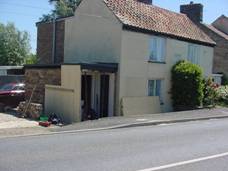
The hole at the front of the house was made by the car
Overview of what happened (but we'll never really know)
Various phone calls followed to discover that the car had come off the road, sliding sideways, hitting the semi-detached two up two down property (luckily with no-one inside) at just after midnight. The neighbours advised that soon after several police cars, fire engines and an ambulance had arrived. The person in the car was rescued, but they had to be cut out. We were also advised that the structural engineers from the local authority had been called out that night, as they were uncertain if the building should be classified as a dangerous structure or not, which had resulted in various acrow props (the trade name for supports) being put underneath the roof of the structure to hold it in place and local builders being called out to board up the property.

Some of the acrow props holding the roof up
The next day's appointments were rearranged so a visit could be made. Surprisingly, upon arriving, as we drove towards the house it looked like very little had happened, due to the way the house had been boarded up (which must have been quite a task as it was dark when the work was being carried out). Outwardly the property looked to have a rendered face as the plywood was the same colour as the render next to it and did not look out of place.
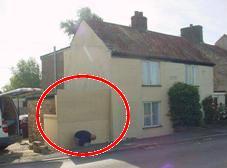
Property with boarding after accident
What do the circles and ovals mean in our building surveys?
In our building surveys and structural surveys the circles and ovals are a system that we used to highlight property problem areas so that you are not left wondering what the property problem is. In addition to this if the survey photographs do not, we believe, explain the property problem enough together with our survey report we also add in one of our own survey sketches.
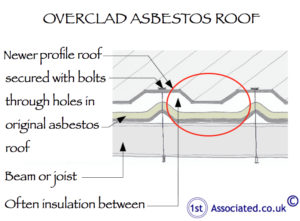
Overclad asbestos roof
Structural damage to the property
Our inspection, as independent surveyors, involved not only looking at the area of impact damage but also the property as a whole, as both the initial impact and the subsequent change in the dynamics of how the structure works could affect the overall structural integrity of the property. There was a hole in the wall, to both the side and front of the property, which is approximately 12 metres squared (far larger than a car). As mentioned, it had taken part of the front and part of the side of the property from ground floor to roof level in some areas, the debris being pushed through the hallway and into the adjoining bathroom and lounge, as well as into the front garden area. This has also hit the mains water supply, bending the pipes over, which had duly been turned off by the emergency services, along with the electricity. The rafters in the flat roof were exposed (this is a single storey extension) and had been supported using acrow props. Bricks are strong in compression but not in tension, as are blocks.
Bricks and blocks are strong in compression but not in tension
The sheer mass of debris is due to a wall being far stronger in compression, which is the downward force, than in tension, which are sideways forces (trees are very strong in tension so don't run into one of these, as the car will be far worse off). The hitting of the wall with the side of the car almost causes an explosion of brick and blockwork, which does make the accident seem much worse than it is.
In the cold light of day; the structural problem
In the cold light of day we can see that the acrow props really had been a belt and braces measure as although the roof timbers have been exposed they were supported by the remaining perimeter walls and an internal studwork wall. We checked the surrounding brickwork and whilst there was some diagonal step cracking (by step cracking we mean cracks that run along the steps of the mortar) there was no further structural damage in the area and that action required was to re-build the outer brickwork wall, the inner blockwork wall and reinstate the pipework.
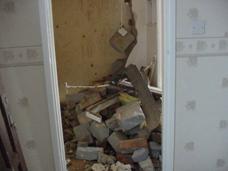
The hallway with the car bumper
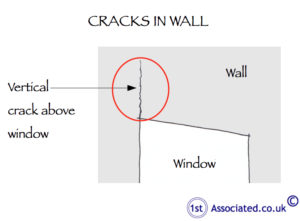
Cracking in render
Inspecting the rest of the house for structural problems
We still thought it was worth inspecting the rest of the property for further structural problems. Our main areas of concern were the two storey gable end wall and the roof as the property was approximately 100 to 150 years old. The wall was being rendered so we weren't certain of the construction and the roof may well have had other property problems, such as wet rot, dry rot or woodworm, which would have caused further problems too.
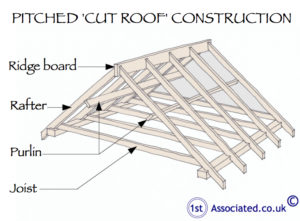
Cut timber frame pitched roof
construction
Inspection for structural problems within the roof
We started by inspecting the roof structure, accessing via the loft hatch. We were pleased to see that the original roof structure had been replaced, probably in the 1960's, with a modern cut timber roof with pre-treated timbers, so there was no obvious visual problems of woodworm, wet rot or dry rot. We examined the truss roof rafters to the end of the property that had the impact closely and could find none that had been split or damaged, so we were happy with the roof space.
Checking the rendered walls for structural damages
We had a close inspection of all the external rendered walls to see if there were any new cracks from the impact damage and were pleased we couldn't find any. The way you spot the difference between a new and old crack is to see how clean the cracking is and if there is any ingrained dirt it. A clean crack without ingrained dirt would tend to be a newer crack. In this case there weren't any.
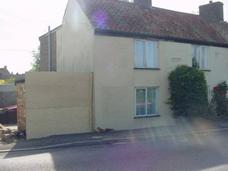
The hallway with the car bumper
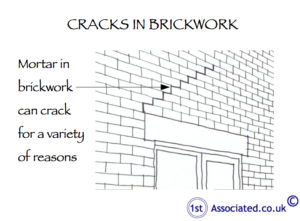
Cracking in brickwork
Getting the building work carried out to sort out the insurance claim
It was important to get the people back into the property so we decided to organise the repair work as quickly as possible. Later that day we met up with a bricklayer as this was the key trade needed, who advised us that the external brick was quite a specialised brick and may be difficult to match. So the hunt began for a matching brick, but first we needed to work out how many. For those that don't know this is as simple as counting the number of courses of brick upwards and across and multiplying to find the number and as difficult as then subtracting all the bricks that you can save and as the bricks are hard to find we were saving as many bricks as we possibly could. The final estimate was 350 bricks and we started our search at Travis Perkins, who duly advised us that they didn't have a brick like that and actually recommended several of their competitors. Luckily we decided to have a look as they did say they had about sixty different types of brick in stock!
First we found a near match and then we found a very good match. At the same time we had been asking around for stocks of old bricks and we managed to find approximately 100 of these that the people were happy to let us have free if we came and took them away. That's when we discovered the price of reclaimed bricks was expensive. We will never look at a brick the same again!
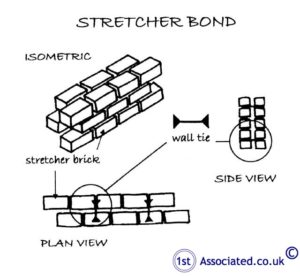
Stretcher bond brickwork
It was also discovered, from further inspection, that the outside brick boundary wall needed rebuilding as well, so we may well be short of bricks but we thought we'd start with 350 and go from there, as they only had about that number. Interestingly there are approximately 520 bricks on a pallet.
So how do builders price work?
It is as simple as the cost of the labour and the materials and any excess requirements, such as trestles, ladders or scaffolding and any equipment such as cement mixers, wheelbarrows, etc and equally it's as difficult as all those things. Labour rates for a skilled tradesman differ considerably in different areas, as does the amount of time that it's estimated to carry out such work.
We decided to do this work on what is known as a day rate, which we wouldn't recommend unless you have close control over the trades people, or a very good working relationship. A day work rate is literally where you pay them for the day's work plus any costs of materials, equipment and excess. So let's have a look at how the quote for this work was built up:
1. 500 bricks that we were buying at 55 pence each £???? which covered an area of ??? metres squared
2. 60 blocks for the inner wall which covered a ???? metre square area £????
3. wall ties to hold them together £????
4. damp proof material of approximately 10 metres £????
5. mortar, which consists of sand and cement; eight bags of cement, twenty of sand £????
6. cement mixer £????
7. wheelbarrow £????
8. brush £????
9. trellis work and scaffold boards for access to the higher level brickwork £????
10. wall tie to allow the bricks and blocks to be tied into the existing hall, known as a brick extender £????
11. delivery costs on top of all of this £???? (the bricklayer comes with the rest of the tools)
12. some pre-mix to make the concrete for re-building the
13. flower bed to the front of the property £????
14. dot and dab plasterboard with skim coat finish £????

Dry Lining Defined
This term comes from the fact that plasterboard is dry and used as an inner lining within the property. Prior to this a wet plaster was used and required drying out periods, which slowed the construction process down. Therefore almost universally in modern properties dry lining is used both as a ceiling material and sometimes to internally line the walls.
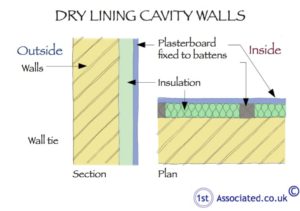
Dry lining
15. new skirtings and two new internal doors £????
16. redecoration of everything £????
17. electric test, as some of the socket points were damaged £????
One element that we can't price is the late night repair work, which included the acrow props and the boarding up.
We then needed to look at the time/labour element of this:-
1. We had one day to clear the site of the rubble and set it up ready to build £????
2. One day to build the inner blockwork £????
3. Two days to build the outer brickwork £????
4. Further day for general tidying up £????
5. Plumbing work mentioned above. One days work for plumber to repair the water pipe that had been run over and switch the water back on. £????
the total cost being £????
Disposing of rubbish
The disposing of rubbish is easier said than done. One of the questions that arose was just how do you dispose of builder's rubbish? We tried the rubbish tip, to be advised that we were only allowed one wheelie bin per week and our van full of rubble exceeded this! After the man extracted a look of horror on our faces he then advised that he did know where we could get rid of the rubble and we were directed to the local quarry. It certainly is like a scene from a different planet!
Having donned our high visibility jackets and driven through the site we finally arrived at the builder's rubble pile.
We also saw this machine, you can just see it in the distance at the centre of the photo, which takes the pile of rubble on the left hand side and makes it into the dust on the right hand side.
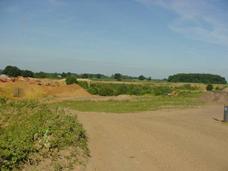
Disposing of rubbish
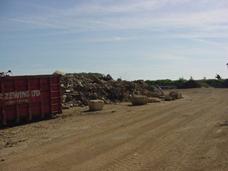
The local quarry
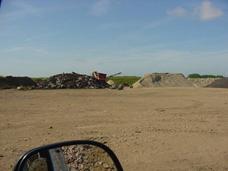
Getting rid of rubble
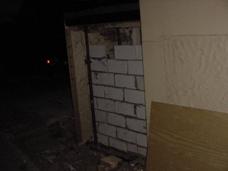
Blockwork inner skin
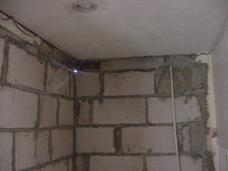
Blockwork up to ceiling height; work progressing on day two
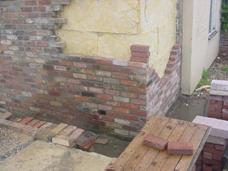
Brickwork starting on day two
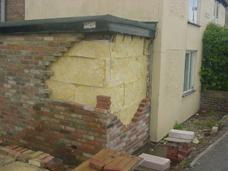
Brickwork progressing on day two
The final stage
The final stage of the project is to put the finishes to the new walls that have been built. This is everything from new light switches and sockets, plaster and paintwork, new skirting and new doors.
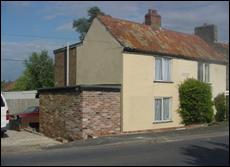
The finished brickwork
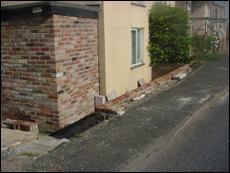
Close up of completed brickwork
How much did it all cost?
We have intentionally not put the costs in but broken everything down. We would be interested in your estimates of how much each section costs.
You may be interested in these other property articles we have prepared:
Structural Cracking
How, in our experience, Insurance Companies deal with Cracks in Properties
Cracks in my Wall
Wall Tie Problems
Cavity Wall Problems
Repairing Cracks
Structural Reports
If you need help and advice with regard to a building claim or insurance claim, commercial surveys, building, structural surveys, structural reports, engineers report, specific defects report, home buyers reports or any other property matters please call 0800 298 5424 for a friendly chat.
If you would like dilapidations help then please visit our www.DilapsHelp.com website and for Disputes go to our Disputes Help site www.DisputesHelp.com .
We hope you found the article of use and if you have any experiences that you feel should be added to this article that would benefit others, or you feel that some of the information that we have put is wrong then please do not hesitate to contact us (we are only human).
The contents of the website are for general information only and is not intended to be relied upon for specific or general decisions. Appropriate independent professional advice should be paid for before making such a decision.
All rights are reserved the contents of the website is not to be reproduced or transmitted in any form in whole or part without the express written permission of 1stAssociated.co.uk.

